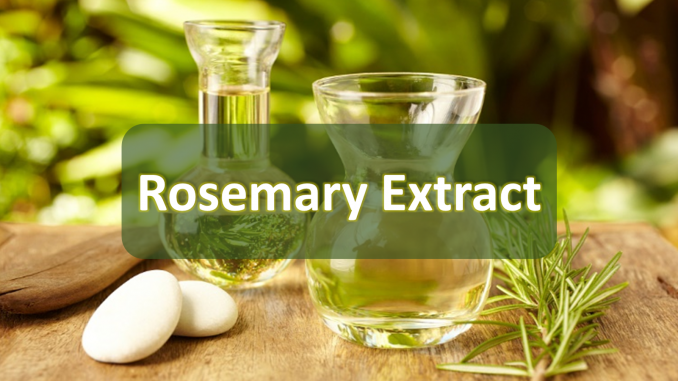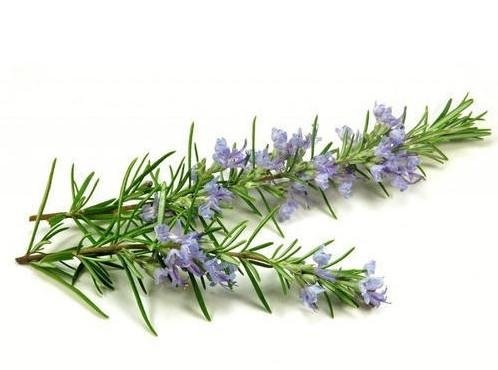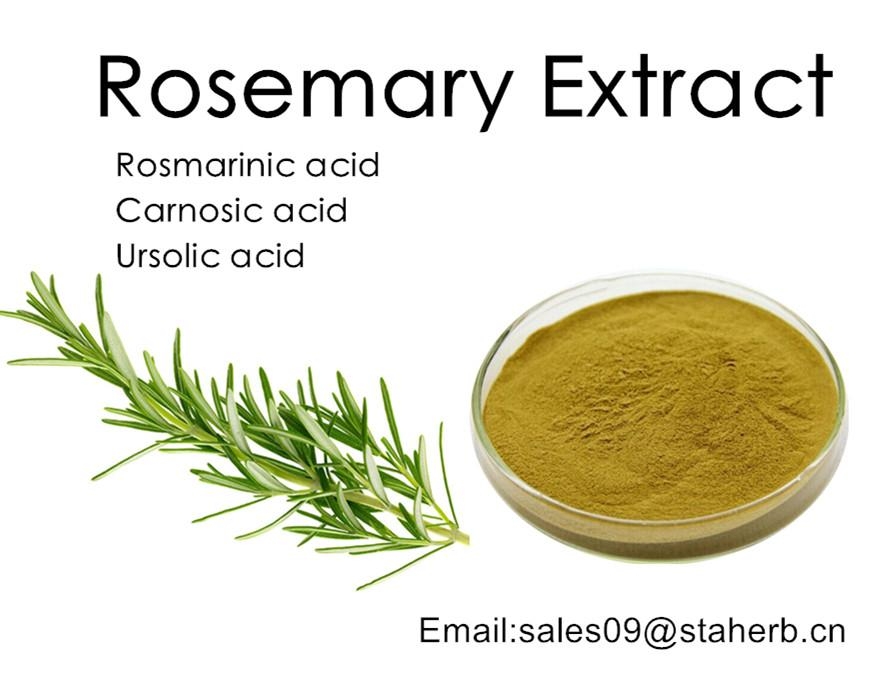
9YR企业会员
发布人:长沙上禾生物科技有限公司
发布日期:2023/1/20 11:35:29
Antioxidant Activity of Rosemary Extract
Rosemary extract is popular as a natural antioxidant due to its strong antioxidant capacity and fat-soluble property. The use of rosemary extract as a natural antioxidant was first reported in 1955. Scientists found that rosemary extract as a natural antioxidant had a better antioxidant capacity than BHT and BHA. It was reported that all rosemary extracts showed strong inhibitory effects on lipid oxidation. The antioxidant capacity of rosemary extract was attributed to the presence of phenolic diterpenes that scavenge singlet oxygen, hydroxyl radicals, and lipid peroxyl radicals, thereby preventing lipid oxidation. Three types of phenolic diterpenes are found in rosemary extract: carnosic acid, carnosol, and rosmanol; with carnosic acid present as the major phenolic diterpene. In addition, studies indicated that carnosic acid was the most active antioxidant component in rosemary extracts.
Rosemary Extracts as Food Additive
It is normally only the leaves of rosemary that are commonly used as a culinary herb, flavoring agent and naturally occurring antioxidant. Today, rosemary extracts are increasingly employed not only to provide flavor but also as natural alternatives to synthetic antioxidants for the stabilization of oxygen-sensitive foods. Extracts of the plant rosemary can have both flavoring and antioxidative properties. In many cases both functions are utilized within a food, however, it can be the case that some extracts are sold primarily for their antioxidant properties. In such cases the processing of the rosemary extract can be optimized to enhance the antioxidative function and to reduce that of flavoring.
Dairy products contain lipids rich in polyunsaturated fatty acids and their esters are easily oxidized by molecular oxygen over time. Deleterious changes in dairy products caused by lipid oxidation include not only loss of flavor or development of off-flavors, but also loss of color, nutrient value, and the accumulation of compounds, which may be detrimental to the health of consumers. One of the most effective ways of retarding lipid oxidation in dairy products is to incorporate antioxidants. Supplementation dairy products with natural antioxidants (polyphenolic compounds) are better using than synthetic antioxidant and could be potentially. The use of rosemary as natural antioxidant in dairy products can reduce the rate of lipid oxidation and hydrolysis besides may be beneficial in increasing the shelf life of these products. This supplementation will move these products into the functional food area under new category as healthy dairy products.
0731-84213302
24小时客服热线:13875855783
销售服务:13687391670 13548561509 18374838656
E-MAIL: sales@staherb.cn agnes@staherb.com
网站:www.staherb.com www.staherb.cn (en)
地址:长沙麓谷高新技术开发区
Rosemary Extract
Active
Ingredients
Specs
Test Method
Appearance
Solubility
Rosmarinic acid
5-95%
HPLC
Brown yellow to yellow powder
Water soluble
Carnosic acid
5-98%
HPLC
Brown yellow to yellow powder
Oil soluble
Carnosic acid
(Oil)
5-20%
HPLC
Brown yellow liquid
Ursolic acid
5-98%
HPLC
Greenish yellow to white
Water soluble
Rosmary
essential oil
GC
Light yellow liquid
Rosemary
Hydrosol

1. Natural antioxidant, which is widelyused in food, functional foods, spices and condiments and daily chemical industries;
2. Anti-aging effect. It can eliminate the free radicals that over-produced by the body and annihilate the singlet oxygen to protect the structure of the cell membrane, which can lead to slow down the aging process;
3. Strong weight-losing effect. It can stimulate and accelerate the metabolism of the fat by anti-oxidant activity. Not only can it lower the blood pressure, but it can also promote the lipid compounds to emit from the manure so as to lose weight;
4. Anti-cancer effect and can be used in the treatment of cardiovascular diseases.
1. As natural antioxidant, it's antioxidant activity is higher than VE. It is widely used in cosmetics, food, fragrance, perfume, shower gel, shampoo, soap and air fresheners.
2. Rosemary extract serves as an excellent nerve and brain tonic and improves memory skills and concentration. The strong, floral aroma of rosemary oil induces relaxation and acts as a stimulant to the nervous system. It is a good remedy for depression, boredom, fatigue and forgetfulness.
3.It provides protection to the brain cells from the effects of aging process and enhances memory.
4. Rosemary extract is well known to protect skin cells that prevent age-related changes in skin such as wrinkles and the formation of dark spots, protects the skin cells from the damage caused by aging and thus delay the occurrence of wrinkles and sagging skin.


Vidak M, Rozman D, Komel R. Effects of flavonoids from food and dietary supplements on glial and Glioblastoma Multiforme cells. Mol Ther. 2015 Oct 23;20(10):19406–32.
Li Y, Go VL, Sarkar FH. The role of Nutraceuticals in pancreatic cancer prevention and therapy: targeting cellular signaling, MicroRNAs, and Epigenome. Pancreas. 2015 Jan;44(1):1–10.
Niedzwiecki A, Roomi MW, Kalinovsky T, Rath M. Anticancer Efficacy of Polyphenols and Their Combinations. Nutrients. 2016 Sep 9;8(9). pii: E552.
Newman DJ, Cragg GM, Snader KM. The influence of natural products upon drug discovery. Nat Prod Rep. 2000 Jun;17(3):215–34.
Gilbert B, Alves LF. Synergy in plant medicines. Curr Med Chem. 2003 Jan;10(1):13–20.
González-Vallinas M, González-Castejón M, Rodríguez-Casado A, Ramírez de Molina A. Dietary phytochemicals in cancer prevention and therapy: a complementary approach with promising perspectives. Nutr Rev. 2013;71:585–99.
Helmerick EC, Loftus JP, Wakshlag JJ. The effects of baicalein on canine osteosarcoma cell proliferation and death. Vet Comp Oncol. 2014;12:299–309.
Wakshlag JJ, Balkman CE. Effects of lycopene on proliferation and death of canine osteosarcoma cells. Am J Vet Res. 2010;71:1362–70.
Wakshlag JJ, Balkman CA, Morgan SK, McEntee MC. Evaluation of the protective effects of all-trans-astaxanthin on canine osteosarcoma cell lines. Am J Vet Res. 2010;71:89–96.
Kelsey JL, Moore AS, Glickman LT. Epidemiologic studies of risk factors for cancer in pet dogs. Epidemiol Rev. 1998;20:2014–7.
Levine CB, Bayle J, Biourge V, Wakshlag JJ. Effects and synergy of feed ingredients on canine neoplastic cell proliferation. BMC Vet Res. 2016 Aug 2;12(1):159.
Sharma RA, McLelland HR, Hill KA, Ireson CR, Euden SA, Manson MM, et al. Pharmacodynamic and pharmacokinetic study of oral curcuma extract in patients with colorectal cancer. Clin Cancer Res. 2001;7:1894–900.
Lee WH, Loo CY, Young PM, Traini D, Mason RS, Rohanizadeh R. Recent advances in curcumin nanoformulation for cancer therapy. Expert Opin Drug Deliv. 2014 Aug;11(8):1183–201.
Douglass BJ, Clouatre DL. Beyond yellow curry: assessing commercial Curcumin absorption technologies. J Am Coll Nutr. 2015;34(4):347–58.
Berginc K, Trontelj J, Basnet NS, Kristl A. Physiological barriers to the oral delivery of curcumin. Pharmazie. 2012 Jun;67(6):518–24.
Shaikh J, Ankola DD, Beniwal V, Singh D, Kumar MN. Nanoparticle encapsulation improves oral bioavailability of curcumin by at least 9-fold when compared to curcumin administered with piperine as absorption enhancer. Eur J Pharm Sci. 2009 Jun 28;37(3–4):223–30.
Pesakhov S, Khanin M, Studzinski GP, Danilenko M. Distinct combinatorial effects of the plant polyphenols curcumin, carnosic acid, and silibinin on proliferation and apoptosis in acute myeloid leukemia cells. Nutr Cancer. 2010;62:811–24.
Einbond LS, HA W, Kashiwazaki R, He K, Roller M, Su T, et al. Carnosic acid inhibits the growth of ER-negative human breast cancer cells and synergizes with curcumin. Fitoterapia. 2012;83:1160–8.
Passos JF, Miwa S, von Zglinicki T. Measuring reactive oxygen species in senescent cells. Methods Mol Biol. 2013;965:253–63.
Kunwar A, Barik A, Mishra B, Rathinasamy K, Pandey R, Priyadarsini KI. Quantitative cellular uptake, localization and cytotoxicity of curcumin in normal and tumor cells. Biochim Biophys Acta. 2008 Apr;1780(4):673–9.
Rasband, WS. ImageJ. U.S. National Institutes of Health, Bethesda, Maryland, USA. 1997-2016.
Wakshlag JJ, Kallfelz FA, Wakshlag RR, Davenport GM. The effects of branched-chain amino acids on canine neoplastic cell proliferation and death. J Nutr. 2006 July;136(7 Suppl):2007S–10S.
Ramos S. Effects of dietary flavonoids on apoptotic pathways related to cancer chemoprevention. J Nutr Biochem. 2007 Jul;18(7):427–42.
Ravindran J, Prasad S, Aggarwal BB. Curcumin and cancer cells: how many ways can curry kill tumor cells selectively? AAPS J. 2009 Sep;11(3):495–510.
Plouzek CA, Ciolino HP, Clarke R, Yeh GC. Inhibition of P-glycoprotein activity and reversal of multidrug resistance in vitro by rosemary extract. Eur J Cancer. 1999 Oct;35(10):1541–5.
Chen J, Li L, Su J, Li B, Zhang X, Chen T. Proteomic analysis of G2/M arrest triggered by natural Borneol/Curcumin in HepG2 cells, the importance of the reactive oxygen species-p53 pathway. J Agric Food Chem. 2015 Jul 22;63(28):6440–9.
Lim TG, Lee SY, Huang Z, Lim DY, Chen H, Jung SK, et al. Curcumin suppresses proliferation of colon cancer cells by targeting CDK2. Cancer Prev Res (Phila). 2014 Apr;7(4):466–74.
Baharuddin P, Satar N, Fakiruddin KS, Zakaria N, Lim MN, Yusoff NM, et al. Curcumin improves the efficacy of cisplatin by targeting cancer stem-like cells through p21 and cyclin D1-mediated tumour cell inhibition in non-small cell lung cancer cell lines. Oncol Rep. 2016 Jan;35(1):13–25.
Kumar D, Basu S, Parija L, Rout D, Manna S, Dandapat J, Debata PR. Curcumin and Ellagic acid synergistically induce ROS generation, DNA damage, p53 accumulation and apoptosis in HeLa cervical carcinoma cells. Biomed Pharmacother. 2016 July;81:31–7.
Mosieniak G, Sliwinska MA, Przybylska D, Grabowska W, Sunderland P, Bielak-Zmijewska A, Sikora E. Curcumin-treated cancer cells show mitotic disturbances leading to growth arrest and induction of senescence phenotype. Int J Biochem Cell Biol. 2016 May;74:33–43.
Tong L, Chuang CC, Wu S, Zuo L. Reactive oxygen species in redox cancer therapy. Cancer Lett. 2015 Oct 10;367(1):18–25.
Deng Y, Verron E, Rohanizadeh R. Molecular mechanisms of anti-metastatic activity of Curcumin. Anticancer Res. 2016 Nov;36(11):5639–47.
Shehzad A, Lee YS. Molecular mechanisms of curcumin action: signal transduction. Biofactors. 2013 Jan-Feb;39(1):27–36.
Khuda-Bukhsh AR, Das S, Saha SK. Molecular approaches toward targeted cancer prevention with some food plants and their products: inflammatory and other signal pathways. Nutr Cancer. 2014;66(2):194–205.
Moore J, Yousef M, Tsiani E. Anticancer Effects of Rosemary (Rosmarinus officinalis L.) Extract and Rosemary Extract Polyphenols. Nutrients. 2016 Nov 17;8(11). pii: E731.
Tai J, Cheung S, Wu M, Hasman D. Antiproliferation effect of rosemary (Rosmarinus Officinalis) on human ovarian cancer cells in vitro. Phytomedicine. 2012;19:436–43.
Tsai CW, Lin CY, Lin HH, Chen JH. Carnosic acid, a rosemary phenolic compound, induces apoptosis through reactive oxygen species-mediated p38 activation in human neuroblastoma IMR-32 cells. Neurochem Res. 2011;36:2442–51.
Fossey SL, Bear MD, Lin J, Li C, Schwartz EB, Li PK, et al. The novel curcumin analog FLLL32 decreases STAT3 DNA binding activity and expression, and induces apoptosis in osteosarcoma cell lines. BMC Cancer. 2011 Mar 28;11:112.
Verheij M, Ruiter GA, Zerp SF, van Blitterswijk WJ, Fuks Z, Haimovitz-Friedman A, Bartelink H. Role of the stress-activated protein kinase (SAPK/JNK) signaling pathway in radiation-induced apoptosis. Radiother Oncol. 1998 Jun;47(3):225–32.
Cul J, Zhang M, Zhang YQ, JNK XZH. Pathway: diseases and therapeutic potential. Acta Pharmacol Sin. 2007 May;28(5):601–8.
Bogoyevitch MA, Ngoei KR, Zhao TT, Yeap YY, Ng DC. CpJun N-terminal kinase (JNK) signaling: recent advances and challenges. Biochim Biophys Acta. 2010 Mar;1804(3):463–75.
Basu S, Kolesnick R. Stress signals for apoptosis: ceramide and c-Jun kinase. Oncogene. 1998 Dec 24;17(25):3277–85.
Johnson CR, Jiffar T, Fischer UM, Ruvolo PP, Jarvis WD. Requirement for SAPK-Jnk signaling in the induction of apoptosis by ribosomal stress in REH lymphoid leukemia cells. Leukemia. 2003 Nov;17(11):2140–8.
Ventura JJ, Hübner A, Zhang C, Flavell RA, Shokat KM, Davis RJ. Chemical genetic analysis of the time course of signal transduction by JNK. Mol Cell. 2006 Mar 3;21(5):701–10.
Li J, Xiang S, Zhang Q, Wu J, Tang Q, Zhou J, et al. Combination of curcumin and bicalutamide enhanced the growth inhibition of androgen-independent prostate cancer cells through SAPK/JNK and MEK/ERK1/2-mediated targeting of NF-κB/p65 and MUC1-C. J Exp Clin Cancer Res. 2015 May 15;34:46.
Kuwabara M, Takahashi K, Inanami O. Induction of apoptosis through the activation of SAPK/JNK followed by the expression of death receptor Fas in X-irradiated cells. J Radiat Res. 2003 Sep;44(3):2013–9.
Davies C, Tournier C. Exploring the function of the JNK (c-Jun N-terminal kinase) signaling pathway in physiological and pathological processes to design novel therapeutic strategies. Biochem Soc Trans. 2012 Feb;40(1):85–9.
Kim J, Freeman MRJNK. SAPK mediates doxorubicin-induced differentiation and apoptosis in MCF-7 breast cancer cells. Breast Cancer Res Treat. 2003 Jun;79(3):321–8.
Lee LF, Li G, Templeton DJ, Ting JP. Paclitaxel (Taxol)-induced gene expression and cell death are both mediated by the activation of c-Jun NH2-terminal kinase (JNK/SAPK). J Biol Chem. 1998 Oct 23;273(43):28253–60.
Kanai M, Otsuka Y, Otsuka K, Sato M, Nishimura T, Mori Y, Kawaguchi M, Hatano E, Kodama Y, Matsumoto S, Murakami Y, Imaizumi A, Chiba T, Nishihira J, Shibata H. Cancer Chemother Pharmacol. 2013;71 Jun,(6):1521–30.
Song Y, Yan H, Chen J, Wang Y, Jiang Y, Tu P. Characterization of in vitro and in vivo metabolites of carnosic acid, a natural antioxidant, by high performance liquid chromatography coupled with tandem mass spectrometry. J Pharm Biomed Anal. 2014;89:183–96.
sales05@staherb.cn sales@staherb.cn
Hidydromyricetin Magnolol Honokiol Apigenin Amygdalin luteolin Myricetin Chlorogenic Acid corosolic acid Ursolic acid Rosmarinic acid
Staherb Natural Ingredients----a good supplier of professional herb extracts, especially those with high purity and standardized production process.
相关新闻资讯